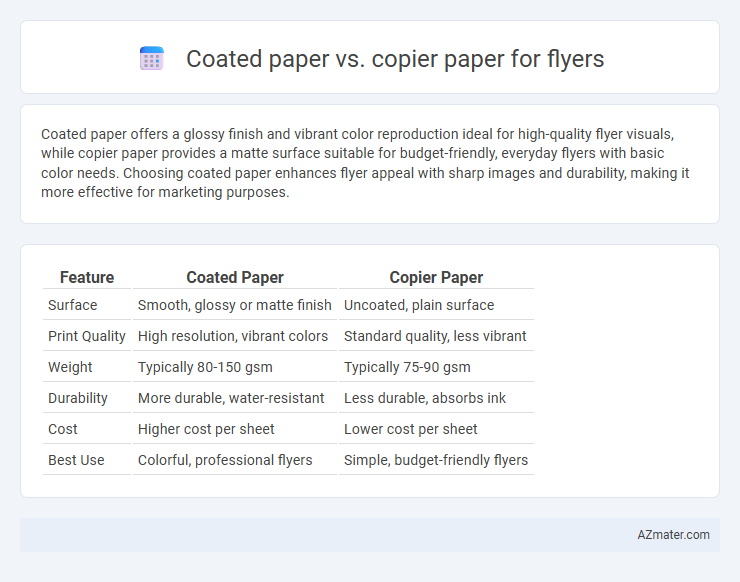Coated paper offers a glossy finish and vibrant color reproduction ideal for high-quality flyer visuals, while copier paper provides a matte surface suitable for budget-friendly, everyday flyers with basic color needs. Choosing coated paper enhances flyer appeal with sharp images and durability, making it more effective for marketing purposes.
Table of Comparison
| Feature | Coated Paper | Copier Paper |
|---|---|---|
| Surface | Smooth, glossy or matte finish | Uncoated, plain surface |
| Print Quality | High resolution, vibrant colors | Standard quality, less vibrant |
| Weight | Typically 80-150 gsm | Typically 75-90 gsm |
| Durability | More durable, water-resistant | Less durable, absorbs ink |
| Cost | Higher cost per sheet | Lower cost per sheet |
| Best Use | Colorful, professional flyers | Simple, budget-friendly flyers |
Introduction to Coated and Copier Paper
Coated paper features a smooth, glossy or matte finish achieved through a layer of substances like clay, enhancing color vibrancy and sharpness, making it ideal for high-quality flyer printing. Copier paper is typically uncoated, lightweight, and more porous, designed for everyday printing tasks with a focus on cost-efficiency and compatibility with standard office printers. Understanding these differences helps determine the best paper type for flyer durability, appearance, and budget considerations.
What Is Coated Paper?
Coated paper features a smooth, glossy, or matte surface achieved by applying a coating of materials such as clay or calcium carbonate, which enhances ink holdout and color vibrancy, making it ideal for flyer printing. This coating provides sharper images and more vibrant colors than uncoated copier paper, resulting in professional-quality promotional materials. Compared to copier paper, coated paper is thicker and less porous, ensuring durability and a premium finish for marketing flyers.
What Is Copier Paper?
Copier paper is a lightweight, uncoated paper primarily designed for use in printers and copiers, featuring a smooth surface that allows for quick ink absorption and fast drying without smudging. Unlike coated paper, which has a glossy or matte finish enhancing color vibrancy and sharpness, copier paper offers a more subdued, natural appearance ideal for everyday printing needs rather than high-impact flyer presentations. Its economical pricing and compatibility with various printing technologies make copier paper a practical choice for mass-produced flyers where cost-efficiency is prioritized over premium visual quality.
Print Quality Comparison
Coated paper offers superior print quality for flyers due to its smooth, glossy or matte finish that enhances color vibrancy and sharpness, making images and text appear more professional and eye-catching. Copier paper, being uncoated and more porous, tends to absorb ink unevenly, resulting in duller colors and less crisp details. For promotional materials requiring high visual impact, coated paper ensures better ink adherence and durability, providing a polished look unmatched by standard copier paper.
Color Vibrancy and Sharpness
Coated paper enhances flyer color vibrancy by providing a smooth, glossy surface that intensifies ink saturation and contrast, resulting in more vivid and eye-catching visuals. Sharpness on coated paper is superior due to its reduced ink absorption, which prevents bleeding and maintains crisp, well-defined edges. Copier paper, being uncoated and more porous, often leads to duller colors and softer image edges, making it less ideal for flyers requiring high-impact graphics.
Paper Durability and Thickness
Coated paper offers superior durability and thickness compared to copier paper, making it ideal for flyers that require a professional finish and extended lifespan. Its smooth, sealed surface resists moisture and wear, enhancing the flyer's resistance to tearing and creasing. Copier paper, typically thinner and less robust, is more prone to damage and often produces a less vibrant print quality.
Cost-Effectiveness for Flyers
Coated paper offers vibrant color reproduction and professional finish for flyers, but its higher cost may limit large-scale distribution budgets. Copier paper provides a budget-friendly alternative with decent print quality, making it suitable for high-volume flyer printing where cost-efficiency is crucial. Businesses seeking maximum reach at low expense often prefer copier paper to balance affordability and effectiveness.
Environmental Impact
Coated paper generally has a higher environmental impact than copier paper due to its use of chemical coatings and additional processing, which complicate recycling and increase resource consumption. Copier paper, often uncoated and produced with fewer additives, typically offers better recyclability and lower emissions during manufacturing, making it a more eco-friendly choice for flyers. Selecting FSC-certified copier paper or using recycled content can further reduce environmental harm associated with paper production and waste.
Best Uses: When to Choose Coated vs Copier Paper
Coated paper offers a smooth, glossy finish ideal for vibrant, high-quality flyer designs that require sharp images and professional appeal, making it perfect for marketing materials and promotional events. Copier paper, with its matte texture and lightweight composition, is best suited for flyers intended for quick distribution or internal use where cost-effectiveness and readability are priorities. Choosing coated paper enhances visual impact for brand promotion, while copier paper supports economical bulk printing for everyday informational handouts.
Final Recommendation for Flyer Printing
Coated paper enhances flyer printing with its smooth, glossy finish that produces vibrant colors and sharp images, making it ideal for high-quality promotional materials. Copier paper is more cost-effective but lacks the polished appearance and durability of coated paper, often resulting in duller prints that may not capture attention effectively. For flyer printing where visual impact and professionalism are priorities, coated paper is the recommended choice to ensure superior print quality and audience engagement.

Infographic: Coated paper vs Copier paper for Flyer
 azmater.com
azmater.com